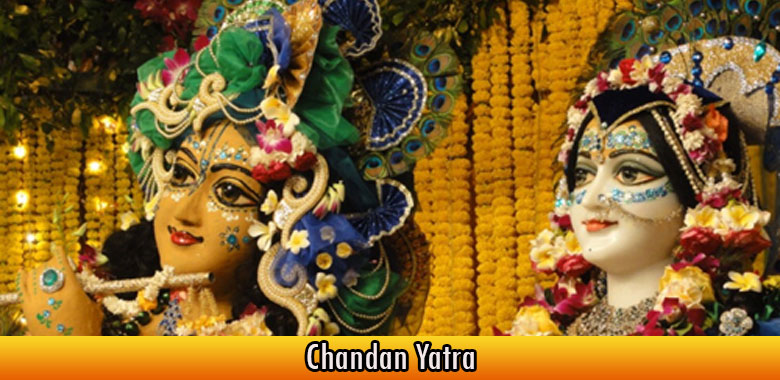Chandan Yatra marks the conclusion of the cycle of religious festivals observed in the famous shrine of Lord Jagannth at Puri followed by similar other shrines of Odisha. The festival, starting from Akshyaya Trutiya, lasts for twenty-one days and is held in the month of Baisakh at the height of the summer heat when Chandan (sandle-paste) and water are essential to keep people cool. As the Hindu deities are modelled on the behaviour of human beings, they are also given the same treatment. During this festival they are taken out of the temples in procession for perambulation in water on floats or boats. The richly decorated boats are called ‘Chapa’. ‘Chapa’ is the Oriya equivalent of ‘float’. In most of the Vishnu as well as Shiva temples the festival of the ‘float’ marks the conclusion of the prime annual festival and it is celebrated with much pomp and eclat. The belief probably is that the deity having concluded his ceremonial perambulation with all attendant paraphernalia on land, must have his aquatic sojourn before He returns to the sanctum of the temple to come out only for the next festival.
This festival is most elaborate in Puri and attracts thousands of pilgrims from far and near. On all the twenty-one days the entire road from the shrine of Lord Jagannath leading up to the Narendra Sarobar (a sacred tank in Puri town) along with the houses on both sides is decorated. At some places, especially in front of Maths (monasteries) or at cross-roads big toranas (arches) are erected where the idols take casual rest and receive offerings The representative images of the deities installed in temples such as Madanmohan (representing Lord Jagannath), Laxmi and Saraswati are taken in a richly decorated palanquin by the sevakas accompanied by priests, musicians and dancers to the Narendra Sarobar at night. The tank is profusely lighted with thousands of spectators milling and jostling all around in expectation of the arrival of the procession. The principal deities are also followed by different deities from different shrines of the town. After reaching the Narendra Sarobar, the images are then placed on different well decorated boats and they are rowed for a long time by the Sevakas. During the rowing ceremony Devadasis (temple-dancers) dance and sing on the boat.
Generally, the colours chosen for the boats are red and white and they are so designed to look like huge swans floating on water. The peculiarity of the ceremony is that Madanmohana with Laxmi and Saraswati rides on the white coloured raft where-as Ramakrishna with pancha Shivas rides the red one. All the deities on the boat take several rounds in the water which continue till early hours of the morning and then retire to the respective shrines.The last day of the festival is called Bhaunri (Bhramari or circle) when special elaborate arrangements are made.
Most of the important festivals of Lord Jagannath at Puri are also followed in all other important shrines of Orissa. Following tradition of the Puri the images are taken out in procession on planquins to the nearby tanks and perambulated in water on boats. In all such temples it is observed only for the last three days. After the ceremony which usually takes place at mid-night, people enjoy performances of dance, drama and music specially arranged for this occasion.
At Bhubaneswar the Chandan festival of Lord Lingaraj is observed in Bindu Sarobar, a huge tank near the temple. Here, the float is moved to the Mandapa in the middle of the tank. The mandap is an inlet-like structure which is more an elevated platform.
Source – Internet
Comments
comments
